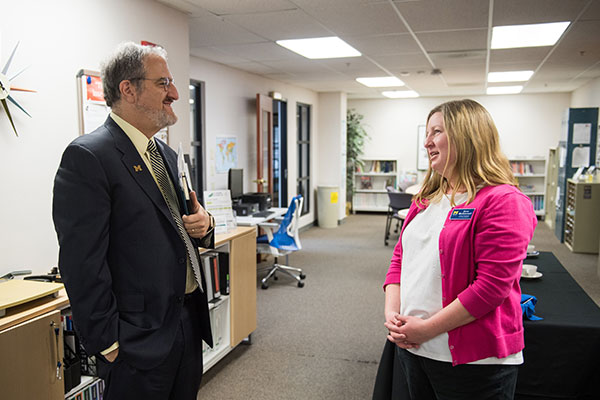UM-Flint Connects Community with Data Through Map Flint

What started as an effort to track kids in the community has turned into a massive system of information glued together by the mapping skills of UM-Flint staff and students.
Map Flint started in 2015 when various organizations in the area teamed up with UM-Flint's University Outreach and Geographic Information Systems (GIS) Center to start compiling data that would offer a growing and comprehensive view of what's happening in the city.
Through creating agreements with local organizations like the Genesee County Land Bank and Genesee County Health Department, UM-Flint is able to compile data and make it accessible through interactive maps.
"The issue isn't that the data is not out there, the data is there. It's how can you find the data and make it user friendly," said Sara McDonnell, a project coordinator in University Outreach. "So that's really the goal, to make publicly available data accessible to the public, to organizations…or researchers trying to find different trends or different problems they can ask questions around."
So…why maps?
"I don't think everybody learns the same way, so I think it's helpful to see information in a lot of different ways. Seeing it on a map helps people understand the spacial relationship and how one thing relates to another," McDonnell said.
"It's another tool in the toolbox. It shouldn't be the only thing people are looking at, but it should be something people have access to."
That works out well for Flint, since GIS specializes in just that kind of thing. In fact, when the city needed help mapping out where it needed to replace lead service lines due to Flint's water crisis, GIS stepped up to the plate to take care of it.
The idea for Map Flint started in 2015 when a committee of local nonprofits that includes Flint Community Schools, the Flint and Genesee Regional Chamber of Commerce, the Charles Stewart Mott Foundation, Ruth Mott Foundation, Community Foundation of Greater Flint, CRIM Fitness Foundation, City of Flint, Flint Area Reinvestment Office, BEST Project, and the United Way, were looking to track where Flint's K-12 students were attending schools.
When UM-Flint was called upon to take up the mapping portion of the project, it grew from there, starting with a $100,000 grant from the Charles Stewart Mott Foundation.
"We kind of broadened the scope because the committee felt that if they're going to invest in this data mapping system it would be better to include all types of information, not just around youth and education," McDonnell said.
"We identified these key themes, and those were education, demographics, and economic development. The GIS Center really worked to build this interactive mapping platform and collect all these different public data sets."
With as much as they've accomplished already, McDonnell said she thinks the project will only continue to grow.
"I don't think it will ever be fully done."
Related Posts
No related photos.
UM-Flint News
The Office of Marketing & Communications can be reached at [email protected].